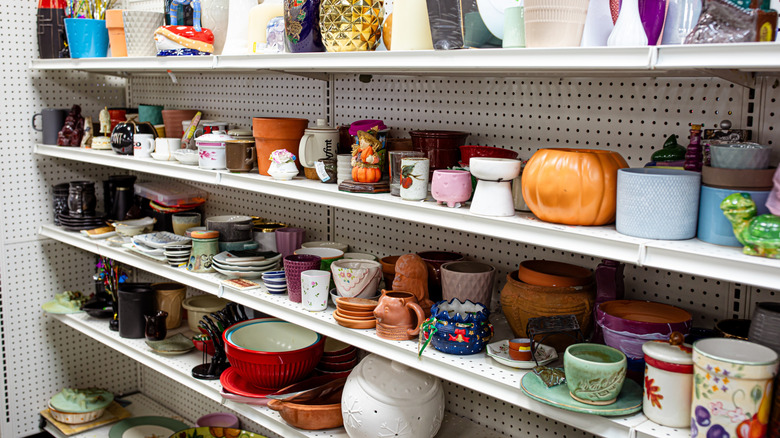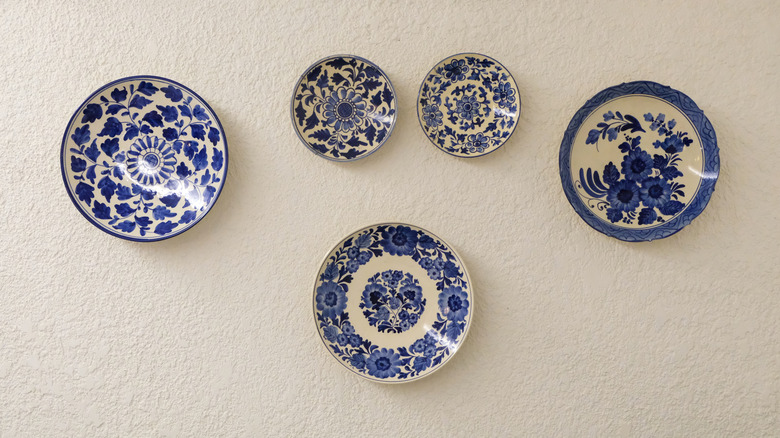The Valuable Kitchen Item You Should Never Overlook At Estate Sales Or Thrift Stores
There's nothing quite as exciting as walking into an estate sale or thrift store. It feels like stepping into a treasure hunt with all the shelves stacked with vintage vases, artworks, and enough glassware to stock a restaurant. A porcelain plate, however, stands out from all the kitchenware as one of the most valuable things to look out for at estate sales and thrift stores.
It can be surprisingly valuable among the sea of items considered as biggest rip-offs that you should avoid buying. They're timeless, and their designs help add sophistication to any kitchen or dining space, after all. Displaying a few on the wall or on an open shelf can instantly give your home that charming feel.
But beyond their aesthetic appeal, porcelain plates can be hidden treasures. Many high-quality plates are made by well-known brands or even hand-painted by skilled artisans. Some brands — like Meissen, Limoges, or Royal Copenhagen — are known for producing porcelain pieces that collectors seek out. A plate from one of these makers could easily be worth more than their thrift store price. And even if you're not looking to sell, knowing that you own a little piece of history adds a special charm to your home.
How to spot valuable porcelain plates
Knowing how to determine authenticity and value is essential before you get too excited and start grabbing every plate in sight. One of the first things to check is the maker's mark on the back of the plate. Well-known brands often leave a stamp that can help identify where and when the piece was made. A quick online search of this marking can reveal whether you're holding something valuable or just some pretty dish.
The condition of the plate also matters. Minor signs of wear can be typical for older pieces, yes, but chips, cracks, or discoloration can significantly lower the value. You can hold the plate up to the light and run your fingers along the edges to feel for any damage. This is important since some cracks might not be visible right away and can become more apparent over time.
Another factor to consider is the design. Hand-painted or intricately detailed plates tend to be more desirable than mass-produced ones. Look closely if the gold or silver accents on a plate are wearing off since this can indicate age and use. Some older plates also have unique features like scalloped edges or delicate embossing that set them apart from modern reproductions.
How to care for and style porcelain plates at home
It's also crucial to take care of your newly-acquired porcelain plate to maintain its beauty and value. One safe option is to handwash it to prevent the details from fading when you place it in a dishwasher. You can instead use mild dish soap, warm water, and a soft cloth to clean it gently. If there are dirt stains or marks, you can remove them by gently scrubbing the area with a sponge and baking soda. Don't use an abrasive tool, bleach, or other chemical cleaners. When you're ready to store the plates, simply place a soft liner or felt between the stacked pieces to prevent scratching. It's also best to avoid overcrowding them in one place.
There are several ways that your porcelain plate can add a touch of elegance to your home if you're not planning to resell your latest find. Hanging plates of varying sizes and patterns on your wall can create an eye-catching display. Be sure to check the tips for perfectly hanging decorative plates. You can also use a plate stand to showcase a special piece on a shelf or mantel. Another option is to use it as a serving tray for small treats or a base for a centerpiece on your dining table. With a keen eye, a little patience, and creativity, you might discover you've scored a piece that's both stunning and surprisingly valuable, not just to your pocket but to your home.

